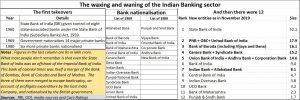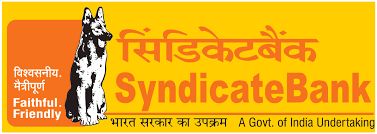https://www.moneycontrol.com/news/business/economy/the-little-known-story-of-once-private-syndicate-bank-which-started-with-a-25-paise-deposit-4422221.html
A requiem for Syndicate Bank
RN Bhaskar – September 10, 2019
On 23 August 2019, ostensibly in an attempt to make Indian banks stronger and better governed, Finance Minister Nirmala Sitharaman announced the mergers of the following banks:
As a part of the process for reaching a $5 trillion economy, the Finance Minister, Nirmala Sitharaman announced the following mergers to trigger a significant consolidation of some public sector banks (PSBs):
- Oriental Bank of Commerce and United Bank of India would be merged into Punjab National Bank. The combined entity would become India’s second-largest PSB (see chart)
- Bank of Baroda to be merged with Vijaya Bank and Dena Bank to become the third largest PSB
- Canara Bank and Syndicate Bank would also be merged making it the fourth-largest PSB.
- Union Bank of India to be merged with Andhra Bank and Corporation Bank and the combined entity would be the fifth-largest PSB
- Indian Bank will be merged with Allahabad Bank; the combined entity would be India’s seventh-largest PSB.
 Whether she succeeds in making the banking sector stronger and more accountable is something only time will tell. But Syndicate Bank deserves to be singled out for an obituary
Whether she succeeds in making the banking sector stronger and more accountable is something only time will tell. But Syndicate Bank deserves to be singled out for an obituary
There are three reasons why Syndicate Bank is important in the evolution of India as a wealth generator, and for working towards the upliftment of the masses.
First because it was born out a belief that an innovative person cannot really generate wealth for himself on a sustainable basis unless he works out a way to make his community wealthy as well;
Second, it was the only large bank in India to locate its headquarters in a rural area – in the 1930s Manipal was still a village.
Third, even before CK Prahalad arrived on the scene, its promoters knew about how wealth could be found at the bottom of the pyramid. At a time when all banks insisted on Rs.5 as the minimum deposit amount to open an account, Syndicate’s promoters opened accounts with just 25 paise. Unfortunately, this is a story that most management schools too do not teach. (More details about Syndicate Bank can be got from Selden Menefee, The Pais of Manipal (Manipal: The Academy of General Education, 1984), and from MV Kamath’s TMA Pai, The Inimitable Banker. The author too has dwelt on this story in his own book).
History
The bank itself was a brainchild of Tonse Madhav Anant Pai (TMA Pai) who went to Bangalore to study medicine and become a doctor. He excelled in his studies, and when earning his licence to practise medicine, he went back home to the fishing village of Malpe. He asked his parents if he could go to Japan for further studies, but was told sternly by his mother that he should stay in the same village and practice medicine for the welfare of the people he grew up with.
That broke the boy’s heart. He wanted to study more. And he knew that a fishing village would provide him neither money, nor the intellectual challenge. He was proved right. In six months’ time, he confirmed that a fishing village had only colds, fevers, diarrhoea, dysentery and indigestion as regular ailments. He tried persuading his parents one more time to let him go overseas for further studies. Once again, he was rebuffed. His relatives would talk of how the boy would go to sleep sobbing into his pillow crying over the unfairness of life.
Till one day, he had his Eureka moment. He realised that one reason why he was not earning enough was because the people around him were also not earning enough. Could he change that? He began strategizing a social revolution that India had never seen or imagined.
He knew, as a doctor, that children are brought o doctors invariably by mothers; seldom by fathers. So he focussed on the women who came to him. He began urging them not to let their children end up like their fathers who were good only for fishing and then getting drunk when they returned to home base. The cleaning of the fish, selling them, managing provisions, balancing incomes with expenses was left to women. If there was any surplus money, the man demanded it, and got drunk with that money.
So he urged the women to save. But they told him that there wasn’t enough money for saving. He would then ask them to show how much money they had. They would show him a few coins. He would gently take a 25 paise coin from each woman and tell her to start with this. Since he was not a bank, he kept two notebooks for each woman – one kept with him and the other with the woman. He told them that he would send his compounder over to her house every day when the husband was not around. If they could save 25 paise, the amount would be registered in both the notebooks. The scheme, backed by constant persuasions and exhortations, worked. Women began saving. In a few months, Pai realised he had more than a thousand rupees – which translates into a few lakhs using today’s valuations. The 25 paise deposit scheme came to be known as the Pygmy Deposit scheme.
It was time to go to phase 2 of the plan. He told them that their children were falling ill very frequently because they consumed only fish and rice. He urged them to give the children a glass of milk every day. That was impossible. A glass of milk was unaffordable.
So Pai urged them to buy a cow for their houses. They laughted. “We cannot afford a glass of milk, and you want us to buy a cow?” they scoffed. But Pai gently told them that he could finance the cows for the women. And repayment was also painless, he explained: “Just give your child a glass of milk, and I shall purchase the rest of the milk from you and adjust the cost of the cow. You don’t have to do anything else.”
It took a while to persuade the first woman. But when she agreed, it was a game of “me too”. Within a short while, there were so many cows in the village that Pai could not purchase all their milk. He therefore formed a milk cooperative.
To handle the amount of money coming in he started a bank — Canara Industrial and Banking Syndicate Ltd — with its headquarters in Manipal. The first branch of the bank started its operations in 1925 at Udupi in Karnataka. By 1937, it had secured its membership as a clearing house in Mumbai. He then started weavers’ cooperatives, who too were financed by the bank. Then to benefit the community he began schools, then colleges and then institutions that taught engineering and medicine. This complex later became the prestigious Manipal Educational Complex.
In fact, to grow the bank, Pai used to look around for good businessmen, who had the urge to grow and both the ability and willingness to repay the amounts borrowed. In one of his travels he met a trader, whom he helped get a yarn licence from the government. That businessman was Dhirubhai Ambani, And that is how a member of the Pai family remained on the board of Reliance Industries as long as he was alive.
The bank grew bigger – and became large enough to become one of the 12 largest banks in India. And that is how it got nationalised in the first round itself (see chart).
In fact, that is another reason why Syndicate Bank is important. It is proof that Indira Gandhi was lying when she said that she nationalised the banks to ensure that they were relevant to the rural sector. Syndicate was a rural bank, with its roots in the rural sector. The truth was that Indira Gandhi wanted to control the purse strings of industries and the funding of political parties. Nationalising banks was her way of consolidating political power.
But as history has shown, when rulers own banks, the temptation to use them for their political agendas often drives them to bankruptcy. That is what happened to the Bank of Calcutta, and the Bank of Madras and then the Bank of Bombay. That is how the banks that have now been merged were driven from profitability to bankruptcy.
Syndicate Bank is an important milestone in India’s evolution because it shows that when entrepreneurs are allowed to become wealth generators, everyone benefits. Politicians who believe that they can run banks invariably bankrupt both banks and the nation too.







































COMMENTS